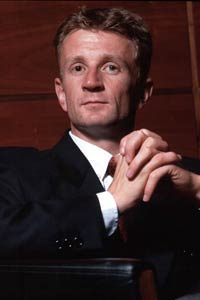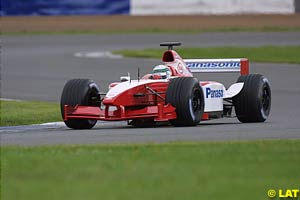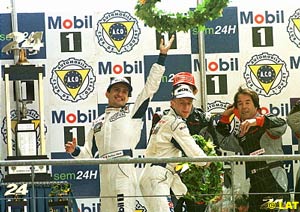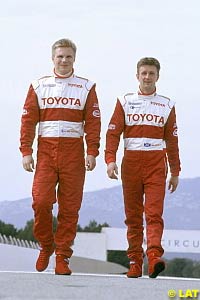
for that Second Chance
Atlas F1 Senior Writer
Ten years passed since Allan McNish was the New Young Hopeful, landing a testing role with McLaren and making his mark in the lower formulas. But somewhere along the line he lost momentum, and found success in different forms of motor racing. Next year he is most likely to get a second chance, driving alongside Mika Salo for newcomers Toyota. Roger Horton met up with the pleasant Scotsman and heard from him about his aspirations, his perception of Toyota's progress, and how very different it is to drive an F1 car today, compared with the cars of a decade ago
Then, at the end of 1991, his career stalled after a year spent struggling with a Lola chassis against the dominant Reynards in F3000, and there were suggestions that his form was affected by an earlier accident at Donington Park, where his car had left the circuit and killed a spectator.
For a while his name was out of the frame and F1 seemed to forget him, the way that only Formula One teams can do it seems; one minute you are the flavour of the month, the next you are on the outside, set to be stuck as a permanent test driver.
He earned his living in the still competitive but less glamorous world of GT racing in America. Then the slow climb back to prominence came in Sports Car racing with Porsche and Toyota. A win at the prestigious Le Mans 24 hour race kept his name in the frame, and when Toyota needed a test driver for their F1 project, the call came.
Now, some ten years after he was last seriously in the running for an F1 seat, he is again awaiting Toyota's formal confirmation that he will indeed fill one of the two race seats with the team next year, alongside Mika Salo. "We should," a team spokesperson confirmed to Atlas F1, "be able to make a formal announcement quite soon."
About a month ago, paddock gossip was suggesting that former Benetton driver and current McLaren tester Alexander Wurz could be the man to spoil McNish's dream. The Austrian is known to be close with the team's new technical director Gustav Brunner, and there is a strong case to suggest that having a driver with such recent F1 experience, and with one of Formula One's premier outfits, could have been of greater benefit to the Cologne-based team.
Then, on the heels of Heinz-Harald Frentzen's shock sacking from Jordan, it was widely believed that Toyota would quickly snap up the experienced German, the lure of going into their initial year with such a seasoned campaigner would surely be too good an opportunity to miss, but this suggestion has also been firmly denied by Toyota.
As far back as the British GP, team insiders were suggesting that Allan McNish's name "could be pencilled in" alongside Salo for next season. So when I spoke with McNish, his contractual situation with Toyota was naturally my first question.
Q: It's fair to say it's 99 percent certain that you will be in Formula One next year?
McNish: "I never like to put percentages on anything, but I think it's fair to say things are going pretty well from both sides, and we both seem to be quite happy with each other. That's obviously the goal, that's the reason we did the deal, and at the moment it's just the case that we are trying to get on with our job, which is to get the car a bit more developed, a bit faster. If we do that correctly, the other side of it should take care of itself to a certain extent."
Q: Speaking of testing, in your recent test at Barcelona, you were about four seconds off the fastest test time there this year...
"But in Barcelona we did make a big step forward. We had a new aero package on the car which was a big benefit, and we generally got to grips with the car and so we were generally much more competitive. But where we are ultimately with the car against the opposition we don't really know right now, we will probably not know until we go to Melbourne (for the first race of next season.) It will be the first time we will have our actual race car as well."
Q: I understand that at Barcelona, you also ran two cars for the first time.
McNish: "Yes, it's the first time we have run two cars in parallel, which was good from a technical point of view because we were able to double up the information. It was also good from a team point of view because running two cars from the same place is a bit more of a difficult job, so they have got to learn to do that as a unit."
Q: Are you running the latest Michelin tyres when you test?
McNish: "Yes, we have to, otherwise you get a bit lost. You have got to try and keep up with the pace of what is happening on the tyre development but it does affect the car. But Michelin doesn't give priority to one team over another, they give everyone the same opportunity. Ok, in the racing at the moment they are going to look at Williams as their main Championship contenders this year and they will I'm sure be drawn a little bit down the technical route to suit them, but overall we all have the same opportunity."
Q: Let's go back and talk a little about your career. It's been a bit of a roller coaster ride, hasn't it?
McNish: "Yes, it has. When I was 19 I was sitting with a McLaren contract and I was leading the British F3 Championship and everything looked pretty rosy, it was only my third year in motor racing and it was all going in the right direction. I mean Mika Hakkinen was my teammate, and when I went to Macau I was racing against Heinz-Harald Frentzen, Michael Schumacher, Karl Wendlinger, you know; it was a pretty strong crop, and I was doing not too badly amongst this lot."
McNish: I don't think there was any one thing that went wrong; there were a couple of things that happened at a similar time that was a bit unfortunate. In 1990 I won two races in F3000 and I finished fourth in the Championship and everything really looked quite good. I led three or four other races and had some reliability problems and my F1 testing with McLaren had been going well. But in 1991 the Lola chassis that we used was a bit of a dog. So anyone using a Lola was never anywhere near to winning a race, so I struggled from that point of view.
"Also I think people's perceptions were a little bit tainted because of an accident I had the year before, so some put down some of my results to the accident; I mean image is a big thing, so from there my momentum was lost a bit. So once your momentum is lost it's hard to get it going again. I mean Jenson (Button) is finding this out now - last year he was the blue-eyed boy, he was the new kid on the block, now this year it's Kimi (Raikkonen) and the spotlight is on him. That's the way it works."
Q: You have been away from the F1 scene for over five years. Does the prospect of going up against all the top drivers again worry you at all?
McNish: "No, not really. At the end of the day, from a racing point of view, I have won in every other category I have been involved in, I've won some big races and championships, so I don't have any particular concerns about that to be honest, it is probably one of my slightest concerns."
Q: But with due respect to these other categories, F1 is all about speed, isn't it...
McNish: "Maybe you haven't been to a Sports Car race lately! If you look at a Sports Car now it is effectively the technology of a Formula One car with a body on the top. They are producing downforce equivalent to F1 cars, the speeds are reasonably equivalent, the biggest difference are that they are 300 kilos heavier, so they are slower to accelerate and slower to brake, that is the biggest difference I found in driving. Obviously an F1 car is different to drive and to race, but at the end of the day it's a racing car, and so part of that you don't forget, and part of it you re-learn.
"This year has been quite good with Mika (Salo), even in Barcelona there were quite a few points I picked up on that he did differently that was due to his experience, things he did, the way he worked, a few little things that he did that I thought, now that's quite sharp, I will store them in my wee mental notebook."
Q: Just how different is this breed of Formula One cars from the one you have driven before, using, lets say, the early 1990s cars you drove as a test driver as a baseline?
"Prior to driving an F1 car again, I thought, jeez, how can the likes of Jenson and Kimi get into the car and drive so quickly straight away? I just didn't really understand. Then I got into this one and you pretty much have very little to do in comparison with what you used to have to do. When you used to drive, you had a gear stick, so you had to balance the brake with the throttle, press the clutch and downshift with one hand going into a corner... sometimes. So you were doing all that sort of dancing act. You had a lot of G force because you had slick tyres; you had 250 litres of fuel in the car at points. So there were a lot of physical aspects of driving the car, there was a lot of balance and control.
"Now you brake with your left foot as hard as you can, you push a button or flick a lever and it is all done for you, so there are a lot of things that are taken out of the driver's control that makes it easier to drive. Also with the aerodynamics now it's not very pitch sensitive, so you don't have to have that finesse in braking like maybe you used to have when the front wing was just an inch off the ground. Now with the front wing 4 inches off the ground all the pitch sensitivity of the car is basically gone, it is just as hard to drive fast, but it is just a bit easier to get closer to the limit.
"There are different things to think about now when you are driving the car on the circuit. There is much less for you to do to physically to get it navigated around. Now it is not a question of just blasting through the race as fast as possible, you have got pit stops to think of, you've got strategy to think of, you have opportunities to change different parameters on the car that you never had before whilst you are driving. So you are maybe thinking about 'how can I make this car go faster' rather than thinking, 'right, I am going to drive this car faster'.
"When I started racing I learned it all by the seat of my pants, I learned to go around a circuit quickly by feeling what was quicker and what was slower. I learned as a kid in a kart that if we changed the exhaust pipe by half an inch, where we were quicker and where we were slower, and when we changed tyre pressures, where we were faster and where we were slower, and not by looking at data. Now in karting you have kids thirteen years old looking at this data and working it out by looking at graphs. It's not better, it's not worse, it's just different.
"So it is easier to go pretty fast, but to get that last bit out of it is just as hard, and I still think that the best people are on pole."
Q: Can you explain just how the link with Toyota came about?
Q: But you weren't thinking about Formula One originally with Toyota?
McNish: "No not really. I knew they were thinking about F1 but I had no thoughts on it, at that time I was contracted to Porsche anyway, I was developing their sports car in the background."
Q: How do you get on with Mika Salo?
McNish: "Pretty well. I have known him for a little while, so from that side it is a little easier. But in the past few months we have gotten on well from a technical point of view. He is very open, very straightforward, quite blunt and direct so from that point of view he is quite easy to read, he is not a devious character by any stretch of the imagination."
Q: Just what personal goals have you set for yourself next year?
McNish: "Being blunt about it, the main person you compare yourself with is your teammate. From a speed point of view and performance point of view, I have a good person to compare myself to and that's Mika. I need to learn a few bits and pieces, that is part of this year, and part of next year as well. But my goals depend a little bit on Toyota, they can't really be separated; I can influence my performance but if the car is very good it makes it easier and I can maybe reassess my goals. I can't say to you my goal is to finish in the points on four occasions, or to finish tenth on four occasions, because I don't really know right now. I just have to get my head down and get the job done."
 Allan McNish was the Jenson Button of the late Eighties: a driver who seemed destined to carry all before him, as he made his way seemingly effortlessly through the lower categories of F3 and F3000 racing and right into an F1 testing role with McLaren.
Allan McNish was the Jenson Button of the late Eighties: a driver who seemed destined to carry all before him, as he made his way seemingly effortlessly through the lower categories of F3 and F3000 racing and right into an F1 testing role with McLaren.
 McNish: "Basically it's a bit unfair to make direct comparisons. Unless you are all there on the same day, the circuit conditions can change so much, and also we have never run the car in qualifying trim, we have never pumped the fuel out, we have never 'gone for it', if you like, and there is quite dramatic differences in lap times when you do that. I don't think it would be much of an advantage for us to do that at the moment; we have too many other things to try and sort out prior to doing that. Qualifying runs will come later in the year.
McNish: "Basically it's a bit unfair to make direct comparisons. Unless you are all there on the same day, the circuit conditions can change so much, and also we have never run the car in qualifying trim, we have never pumped the fuel out, we have never 'gone for it', if you like, and there is quite dramatic differences in lap times when you do that. I don't think it would be much of an advantage for us to do that at the moment; we have too many other things to try and sort out prior to doing that. Qualifying runs will come later in the year.
 Q: So what went wrong?
Q: So what went wrong?
 McNish: "That is one thing that is very different. Being honest about it, they are a lot easier to drive, physically they are a lot easier to drive, and mentally they are a lot easier to drive.
McNish: "That is one thing that is very different. Being honest about it, they are a lot easier to drive, physically they are a lot easier to drive, and mentally they are a lot easier to drive.
 McNish: "In 1998, I was racing with Porsche and we were fighting with Toyota for victory at Le Mans and ultimately we (Porsche) won and Porsche pulled out at the end of the year. So Toyota contacted me and asked me it I wanted to be involved. I had quite a few options and I went to the factory and the fact that really swung me in their favour was not because they had been competitive the year before, but I asked them some pretty direct questions about the car, about how many laps they wanted to do at Le Mans, various things about that race, that if I went to another team they probably wouldn't want me to know, but they came out and told me straight away. I went to other teams and they said, no sorry, we can't tell you that information. So I thought, well, if they are that confident and determined to do it, they are the right team for me and it proved to be correct. But that contract was only for Le Mans, but after that race they contacted me and asked me if I was interested in this project."
McNish: "In 1998, I was racing with Porsche and we were fighting with Toyota for victory at Le Mans and ultimately we (Porsche) won and Porsche pulled out at the end of the year. So Toyota contacted me and asked me it I wanted to be involved. I had quite a few options and I went to the factory and the fact that really swung me in their favour was not because they had been competitive the year before, but I asked them some pretty direct questions about the car, about how many laps they wanted to do at Le Mans, various things about that race, that if I went to another team they probably wouldn't want me to know, but they came out and told me straight away. I went to other teams and they said, no sorry, we can't tell you that information. So I thought, well, if they are that confident and determined to do it, they are the right team for me and it proved to be correct. But that contract was only for Le Mans, but after that race they contacted me and asked me if I was interested in this project."
Please Contact Us for permission to republish this or any other material from Atlas F1.
|
Volume 7, Issue 32
Put Your Hands Together for the Twelfth Team
Allan McNish: Waiting for that Second Chance
Marketing: Toyota Bets on Speed
Ove Andersson Wants Respect
Q&A with Richard Cregan
Columns
The Jean Alesi Trivia Quiz
The F1 FAQ
The Weekly Grapevine
> Homepage |
